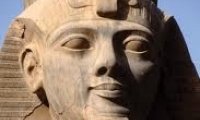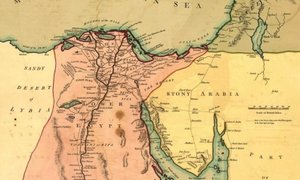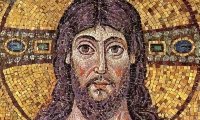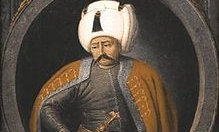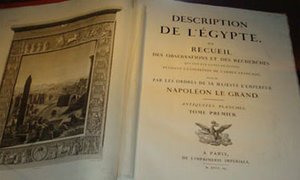"A good knowledge of things past is an armour against events to come".
- Edward Counsel
The first presence in Sinai dates back 8.000 years when early bronze age settlers arrived in search of valuable metals. They developed the copper and turqoise mines in South Sinai. In 2500 BC a nomadic tribe (Hyksos) from western Asia crossed Sinai to invade Egypt and during their occupation there was no Egyptian activity in the mines and quarries of Sinai, where the Egyptian pharaohs, who asserted control over Sinai in 3100 BC, got their precious stones. Sinai primarely served as a mining region and as a military route like for the armies of pharaoh Ramses II.
Prophet Abraham (Ibrahim) was believed to have crossed Sinai and centuries later Prophet Moses (Moussa) spent his live here, leading the epic Exodus - as detailed in the Hebrew Bible. This included numerous halts over a 40-year period of travel. The route and the date of their Exodus are still matters of debate.
Likewise Sinai is famous as the scene where Moses received the Ten Commandments. Some believe Mount Sirbel was the actual site where Moses received the Ten Commandments while others believe it was Mount Sinai.
Judaism, Christianity and Islam - all know Sinai as a holy land. The Torah details the journey of Prophet Moses through Sinai, the Bible documents the journey of Mary (Miriam), Joseph (Yousef) and Prophet Jesus (Isa) across Sinai en route to the mainland and also in the Quran, Sinai is mentioned more than 10 times.
A road along the Sinai’s northern coast served as the principal trade route between Egypt and Palestine for many centuries. It is likely that Egypt erected a chain of (undiscovered) fortresses to guard this route.
The power of the Pharaohs waned and the power of the Greeks and Romans waxed in northern Sinai, while Christian refugees (fleeing Egypt from persecution) began to build isolated settlements.
After the decline of the Egyptian empire, Nabataeans from Petra controlled the trade routes of Sinai for two centuries until they were defeated by the Romans. In the year 106 Sinai became part of the province of Arabia in the Roman Empire. By the year 500 Sinai fell into the Christian realm of Byzantium.
During the early Christian period Sinai became the home of a large number of hermits and ascetics, particularly in the mountains of South Sinai.
But Sinai has not only been traversed and visited by prophets, saints and pilgrims but also several famous conquerors with their armies. In the year 332 Alexander the Great crossed Sinai on his way to Egypt, where he founded the city of Alexandria.
In the year 530 the Byzantine emperor Justinian I began building the Sinai Monastery (nowadays the Monastery of St. Katherine) on the lower slopes of Mount Sinai. It provided a centre for the scattered communities of Christians in the area and served as a pilgrimage site throughout the Middle Ages.
In the year 640 Sinai was the path by which the famous conqueror Amr swept down into Egypt, bringing Islam in his wake and pilgrims from Egypt to Mecca.
With the crusades Sinai, once again, became a thoroughfare for armies and fortresses were built, like the one on Pharaoh's Island close to Taba.
After the crusades Bedouin tribes from the east arrived and became the rulers of Sinai, where they lived relatively undisturbed for several centuries, establishing migratory territories and cultural traditions that lasted well into our own time.
In the year 1796 Egypt revolted against the Ottomans and managed to achieve a semi independent status.
In 1798 Napoleon Bonaparte invaded Egypt in an attempt to reduce the British influence in the region. He arrived at the city of El-Arish in 1799, where he faced difficulties in attacking the fortified Arish Castle. Alongside this military aim, he aimed to explore and survey the ancient lost civilization. He created teams of experts such as surveyors, engineers, astronomers, chemists and botanists as well as artists, architects and archaeologists.
In the year 1182 the famous Salah el-Din (Saladin) crossed Sinai with his army. Salah el-Din later became sultan of Egypt and Syria and ruled over Hejaz, Yemen and Mesopotamia.
In the year 1517 the Ottoman Turkish Sultan Selim I invaded Egypt via the coast of Sinai and Sinai became a part of the Ottoman Empire, administered by an official sent from Constantinople (now Istanbul). Conditions in the Sinai deteriorated, and traveling there became difficult after Egypt became independent of direct Turkish rule in the early 19th century.
Napoleon's ambition was to bring Egypt up to the same level of civilization, culture and development as some European nations enjoyed. European interests began to influence Egypt's politics and started the awakening of nationalism. The first efforts to build the Suez canal came from his Egypt expedition (he hoped the project would create a devastating trade problem for the British). Napleon also recognized the religious importance of the Sinai Monastery, which in the 11th century was named after the Saint Katherine, and regulated the relations between the monastery and the state.
Muhammad Ali Pasha was an Albanian commander of the Ottoman army that was sent to drive Napoleon's forces out of Egypt, but upon the French withdrawal, seized power himself with the support of the Egyptian people and forced the Ottoman Sultan Mahmud II to recognize him as Wāli (say like Governor) of Egypt in 1805. He took the title of Khedive (Viceroy) and transformed Egypt into a regional power, which he saw as the natural successor to the decaying Ottoman Empire. He was a reformist and is regarded as the father of the modern Egypt.

